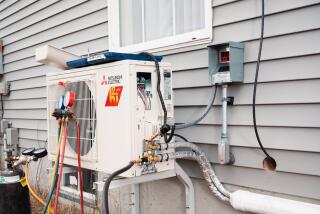Learn some tricks of the green-building trade
- Share via
Green Building A to Z
Understanding the Language
of Green Building
Jerry Yudelson
New Society Publishers: 219 pp., $16.95
--
Green Building & Remodeling for Dummies
Eric Corey Freed
Wiley: 362 pp., $21.99
As the phrase “green building” becomes fixed in the American vocabulary, a big question arises: What exactly is it?
The concept of green building has evolved over recent decades. In the 1960s, the back-to-nature movement meant log cabins, sod roofs and wood-burning stoves.
However, the population of the country has nearly doubled since 1960, from 179 million to more than 300 million today. And with housing units increasing from 58 million in 1960 to more than 112 million today (according to the U.S. Census), there is growing awareness that buildings -- how they are constructed, operated and deconstructed -- are a major part of either the problem or the solution to current crises with energy, water, pollution and global warming.
Some estimates say buildings are responsible for 40% of all greenhouse gas emissions.
The focus today is not so much on “getting in touch with the Earth” as saving it from environmental catastrophe.
And a slew of new books aims to help us understand how building green can move that cause along. Among them are “Green Building A to Z: Understanding the Language of Green Building” and “Green Building & Remodeling for Dummies.”
Both books have merit, but each provides a different perspective.
Green building is often broken down into three areas of concern: 1) energy and water efficiency, 2) renewable and recycled materials and 3) health and comfort.
That simple, and simplified, shorthand is good to remember when the barrage of green-building terms and abbreviations comes your way: on-demand water heaters, rigid foam insulation, gray water system, CFC, VOC, LEED and LED.
“Green Building A to Z” lays it all out in alphabetical order, which is what you might expect from an engineer (they tend to be linear and organized), and its author, Jerry Yudelson, is one of those, as well as a respected expert in the green-building field.
There is a certain comfort in grazing through an alphabetical listing of green-building terms without trying to figure out where each of them fits in the scheme of things.
The eclectic list begins with architecture 2030 (a goal to eliminate greenhouse emissions from new buildings by 2030) and continues with access to transit, bicycle commuting, big picture, biodiesel, biophilia (the hypothesis that human beings have an instinctive bond with all other living things), brownfields and building codes.
The writing is clear, and each selection is brief and, thank goodness, not overly technical.
One caution: Yudelson is highly immersed in the U.S. Green Building Council’s LEED rating program (Leadership in Energy and Environmental Design) and the book is promotional toward that system. However, he does discuss other systems, albeit much more briefly, such as the green globes system favored by the lumber industry and others.
“Green Building & Remodeling for Dummies” is less focused on the theory of green building and more on the practicalities of getting it done. The bulk of the 362-page book is laid out in three sections that zero in on materials, methods, and systems and site planning.
This isn’t a goofy book for goofy people, despite the “Dummies” title. Author and architect Eric Corey Freed, like Yudelson, has a high profile in the green-building industry and obviously broad knowledge of the subject.
This is an easy and engaging book to read with lots of lists, tips and checks and subheads in an informal handwriting script that explains things such as what engineered lumber is, the pros and cons of insulated concrete forms and planning your site to incorporate outdoor rooms.
I’m hard-pressed to recommend one of these books over the other. One strategy would be to read the alphabet book first to get a sense of the whole span of green-building thought, and then read the “Dummies” book to get down to business. In any case, it would be good to get up to speed on green building as the threat of global warming will likely give the topic more traction than it had 40 years ago.
More to Read
Sign up for our Book Club newsletter
Get the latest news, events and more from the Los Angeles Times Book Club, and help us get L.A. reading and talking.
You may occasionally receive promotional content from the Los Angeles Times.







